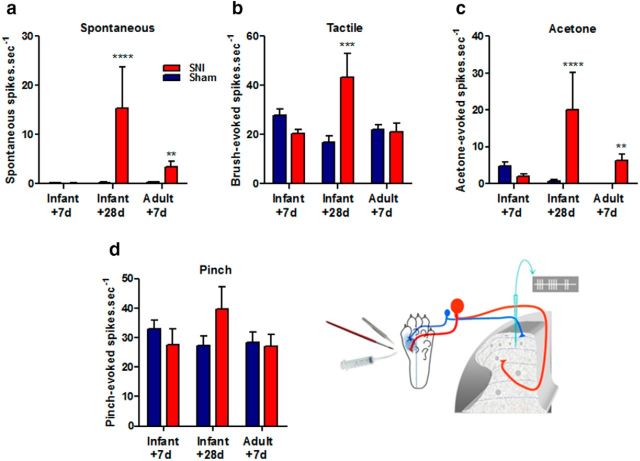Figure 3.
Infant nerve injury leads to a delayed increase in the activity of deep dorsal horn neurons at adolescence. Activity of wide dynamic range neurons in the rat dorsal horn were recorded in response to pinch, tactile brush, and acetone applied to the sural nerve territory of the lateral plantar paw, as illustrated. Spontaneous activity in the absence of stimulation was also recorded. The graphs show that (a) in rats 28 d after infant SNI and 7 d after adult SNI, spontaneous activity of dorsal horn neurons increases compared with sham controls (Infant + 28 d: Sham:0.27 ± 0.11 spikes · sec−1, n = 10 neurons; SNI: 15 ± 8.5, n = 10, p < 0.0001; Adult + 7 d: Sham 0.31 ± 0.14 n = 19; SNI 3.5 ± 1.0 spikes · sec−1, n = 16, p = 0.0049). b, There was also a significant increase in dynamic tactile (brush) evoked activity but only in rats 28 d after infant nerve injury (Infant + 28 d: Sham:17 ± 2.7, n = 15; SNI: 43 ± 9.6, n = 10, p = 0.0009). c, Acetone-evoked activity increases relative to sham controls in both infants 28 d after SNI and adults 7 d after SNI (Infant + 28 d: Sham:0.70 ± 0.35, n = 11; SNI: 20 ± 10, n = 9, p < 0.0001; Adult + 7 d: Sham 0.08 ± 0.05 n = 9; SNI 6.3 ± 1.8, n = 16, p = 0.0097). d, There were no significant differences in pinch evoked activity at any age following SNI (n = 15–20 neurons per group). All data expressed as mean ± SEM neurons recorded from 3 to 4 animals per group and tested for significance using the Mann–Whitney test (**p < 0.01, ***p < 0.001, ****p < 0.0001).

